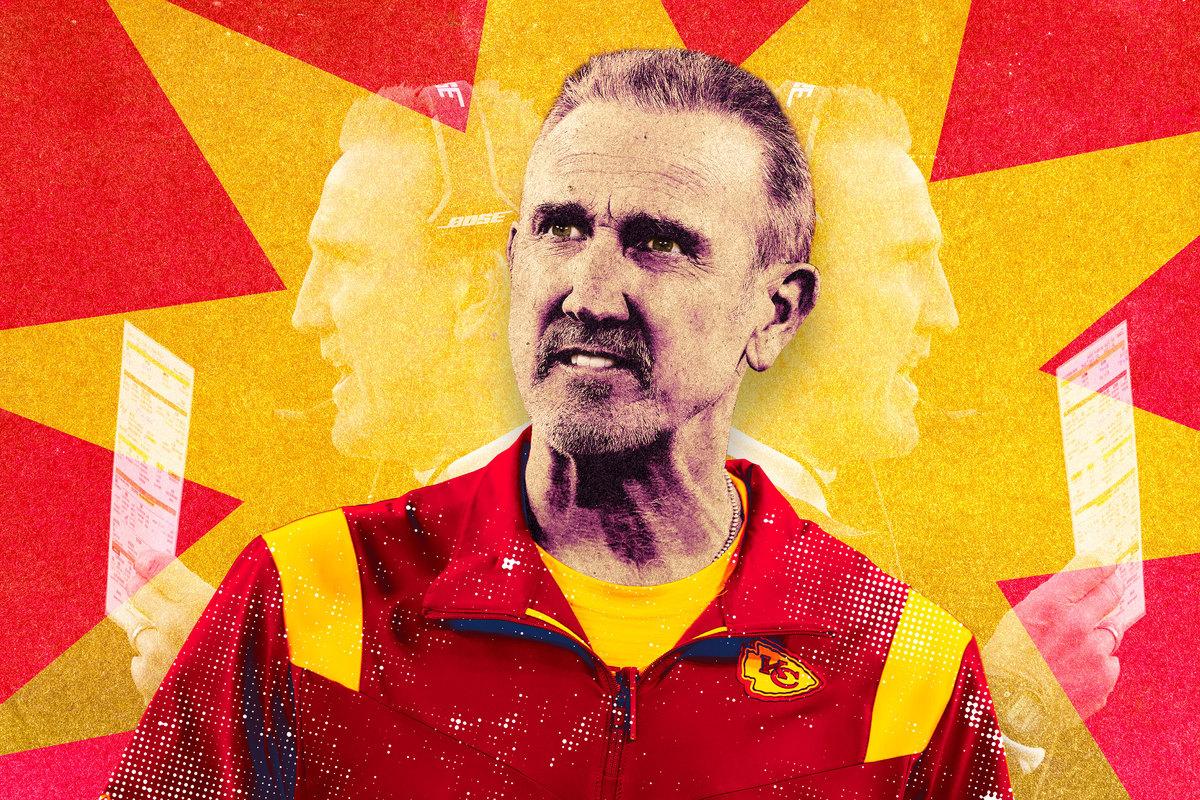
Earlier this season, someone wrote a very silly and shortsighted piece about the Chiefs defense. The author argued that the Chiefs defense was “bad enough that it could derail the team’s Super Bowl aspirations.” He claimed that the Chiefs were “on pace to be the league’s worst defense this season.” The only hope Kansas City had, the author foolishly argued, was that the offense would be “so good that none of this will matter.”
Ah, wait. There’s something rather important I forgot to mention. I wrote that piece.
Two months ago—almost to the day!—I dropped that piece on Kansas City’s defense, and I did it because I was right. I will not be gaslit into believing otherwise. The Chiefs were on a historic pace in both offensive excellence and defensive ineptitude at the quarter pole of the season, and the Chiefs were in danger of losing the top seed in the AFC and failing down the playoff stretch.
And that conclusion remains true! The Chiefs are in danger of losing the top seed in the AFC—their 14 percent chance is third in the conference, behind the Patriots (45 percent) and Titans (22 percent)—and are 0-4 against current AFC playoff teams. But while the destiny of the Chiefs may be preordained, the process couldn’t have taken a sharper U-turn than my feeble October predictions. For the first time in Kansas City’s history under Andy Reid, the offense isn’t carrying the defense—it’s the other way around. The Chiefs’ are 6-1 through their past seven games, and their defense has not only returned to league-average levels, but surged to become one of the league’s most dominant defenses.
We can see this reflected in the numbers. This is where the Chiefs ranked in a few catch-all metrics when I wrote the piece after four weeks, and where they rank now in terms of season-long production.
Chiefs Production
It’s very rare to see a unit get this much better in one season, and accordingly, diagnosing just how they took the leap is really tough. It takes a village to be as bad as the Chiefs were, and it takes the village again to get as much better as they did. Well, the village and Melvin Ingram, I suppose: The Chiefs traded for the Steelers’ pass rusher at the deadline, and he started taking snaps for them in Week 9, which was right around when the defensive leap began. Let’s start there.
The best thing Melvin Ingram ever did for the Chiefs was put Chris Jones back where he belongs: on the defensive interior. With Frank Clark injured for the beginning of the 2021 season and worryingly little depth behind him, the Chiefs had a defensive end problem to start the year. They tried to solve that problem with Jones, playing him almost exclusively as an outside pass rusher despite his All-Pro abilities on the interior. It wasn’t a totally bad idea—Aaron Donald showed in 2020 that he could do a lot of damage from defensive end—but it was fairly evident, fairly quickly, that Jones’s impact was diminished by the new alignment.
Jones missed Weeks 5 and 6—two more terrible weeks for the Chiefs’ defense—before returning in Week 7, with Clark active as well. The snaps started to level out, especially when Ingram was added in Week 9. Suddenly, Jones returned back to his traditional career distribution of snaps: a sprinkling of reps as a big defensive end, but a majority of reps at defensive tackle.
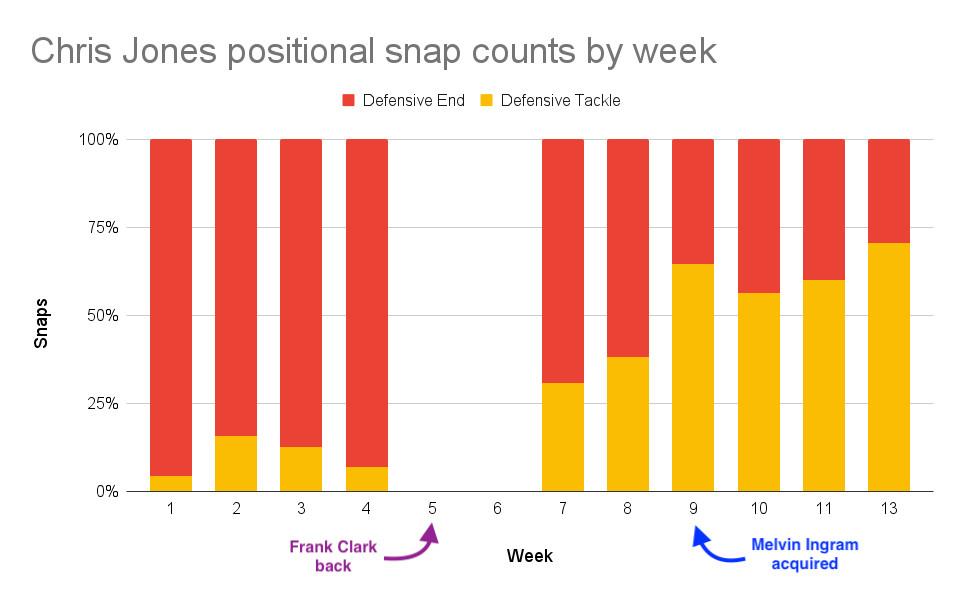
After returning from injury, Jones’s production skyrocketed. Jones is fifth in Pro Football Focus’s pass rush productivity among all defensive linemen since Week 7; for predominantly interior rushers, his PRP of 10.4 is miles above the next closest player (Jonathan Allen at 8.5). Just like the Chiefs’ total defensive improvement, that leap has a lot of factors contributing to it. Some of it is improved health; some of it thanks to a better supporting cast, like Clark and Ingram; some of it is because of easier opponents. But as Next Gen Stats shows us, the core truth remains the obvious explanation: Jones is just much better as an interior rusher than he is an outside rusher.
Ingram has been more than a placeholder for Jones’s outside snaps; he’s been legitimately good in his own right. Ingram has always been one of the more unique players in the league. He rushes predominantly from stand-up, outside alignments—but he doesn’t often drop into coverage, and he doesn’t really win the outside corner with speed. At 247 pounds with a physical play style, Ingram loves to work inside of tackles, crashing into the B gap and blowing up blocking schemes with his physicality and surprising play strength. Defensive coordinator Steve Spagnuolo, a veteran coach, hasn’t really prioritized players with that mold in the past. But to his credit, he has done an excellent job letting Ingram play to his strengths within the structure of the defense.
Most of Ingram’s top plays aren’t reflected in the box score or even advanced stats, because he isn’t nearly as much of a producer as he is a disruptor. He makes life easier for the rest of the defense—for Jones, but also for the linebackers fitting the run behind him, or the safeties flying in on blitzes—by regularly creating havoc on which his teammates can capitalize.
Ingram acts like a force multiplier for the Chiefs defense, but he isn’t the only one. The Chiefs made the trade for Ingram at the deadline, but before that, they made the call to switch up one of the starting roles on their defense. Safety Daniel Sorensen, a veteran player with the athleticism to fill a few spots in Spagnuolo’s flexible defensive backfield, had a giant red target painted on his back by offensive coordinators. Sure, he could play both safety and linebacker responsibilities equally well, but during the first few weeks of the season, that just meant he was equally bad at both positions. Through the first five weeks of the season, quarterbacks had a near-perfect passer rating when throwing at Sorensen in coverage.
So the Chiefs benched Sorensen. That idea seemed easy enough, and it became even easier when you realized the guy behind him was Juan Thornhill, a former second-round pick who delivered promising play at times during his first two seasons as a pro. Thornhill’s placement behind Sorensen on the depth chart has always been a bit of mystery in Kansas City. Spagnuolo said in September that Thornhill needed to “earn his way back” into the starting lineup—but in 2019, Thornhill had already unseated Sorensen on the starting roster, until a torn ACL knocked him out of the playoffs. Both Thornhill and the coaching staff alluded to mental blocks coming off of the injury that hampered Thornhill’s play in 2020, but whether or not those were leaking into 2021 was unclear.
Regardless, the Chiefs had to do something about Sorensen, so Thornhill got the start over him in Week 6. Since then, Kansas City has never looked back. Sorensen has never come close to out-snapping Thornhill since and now operates almost exclusively as a dime linebacker who the Chiefs are slowly onboarding into his more situationally specific role.
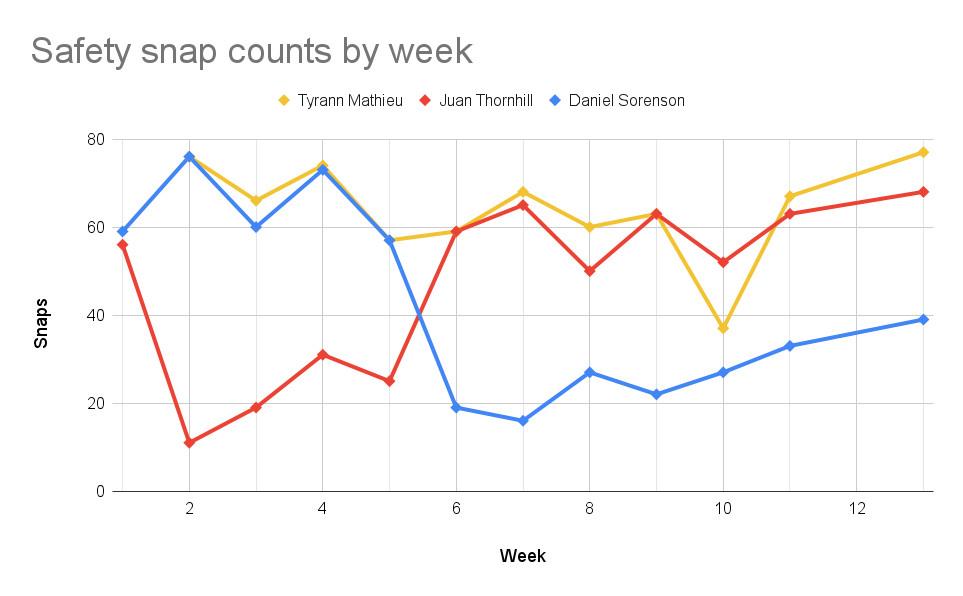
And whatever Thornhill or the Chiefs’ coaching staff did for his recuperation, it worked. Thornhill has been plain, old-fashioned good during the past few weeks. Thornhill is a deep middle safety who can also play some man coverage in quarters, and he gives the Chiefs a true centerfielding playmaker who allows them to play star safety Tyrann Mathieu closer to the line of scrimmage, where he’s best. Just as Ingram has pushed Jones back to his optimal position, the emergence of Thornhill has done the same for Mathieu.
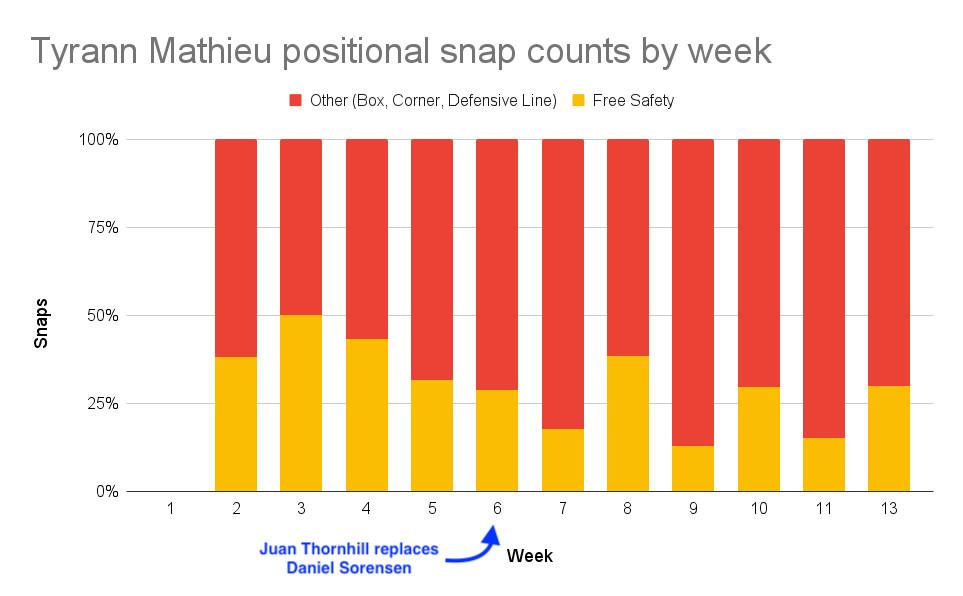
And even as Mathieu has spent more time in the box, the Chiefs have been able to level out those responsibilities and truly play Thornhill and Mathieu as interchangeable chess pieces. This was always the vision when Thornhill was drafted to join Mathieu: The Chiefs would have two true combo safeties, like the Packers with Adrian Amos and Darnell Savage Jr., or the Chargers with Derwin James and Nasir Adderley, such that they can run a variety of coverages and keep their intentions disguised.
So Thornhill maximizes Mathieu just as Ingram maximizes Jones, but the similarities don’t end there. The defensive front has also been boosted by the return of a healthy Frank Clark, and the defensive backfield by the return of a healthy Charvarius Ward. Ward missed weeks 3 through 6 with injury, and the Chiefs experimented with a combination of Rashad Fenton, Mike Hughes, and DeAndre Baker to replace him at outside corner. Fenton won that job eventually, but nobody played as well as Ward did. Once he came back in Week 7, supported by a truly impactful deep safety in Thornhill, his play really started to take off.
For everybody following along thus far, a quick recap: The Chiefs got better (and healthier) at defensive end, which helped them get better at defensive tackle, and they also got better at safety, and also got healthier at cornerback. So, that wild, shocking, unprecedented improvement on defense the Chiefs have enjoyed recently? It’s starting to make a bit more sense.
There’s one position that we haven’t addressed, of course, and that’s linebacker. This was the position that I really hammered in that ill-fated look at the Chiefs’ defense in October. At the time, the Chiefs were starting Anthony Hitchens and rookie Nick Bolton at linebacker, with Ben Niemann in as the third guy in for base sets. The return of Willie Gay Jr., a second-year player out of Mississippi State who was on injured reserve, spelled the only hope for an improvement in the Chiefs linebacking corps.
Any of this sound familiar? You should know the rest of the story by now. Gay became available in Week 5 and has now become the primary snap-getter at linebacker—even above Hitchens and Bolton, the latter of whom has been benched for the past few weeks. Bolton was the player whose early-season performance particularly concerned me–counting stats had him as a productive tackler around the line of scrimmage, but film bore him out as a player with limited range and poor change of direction skills.
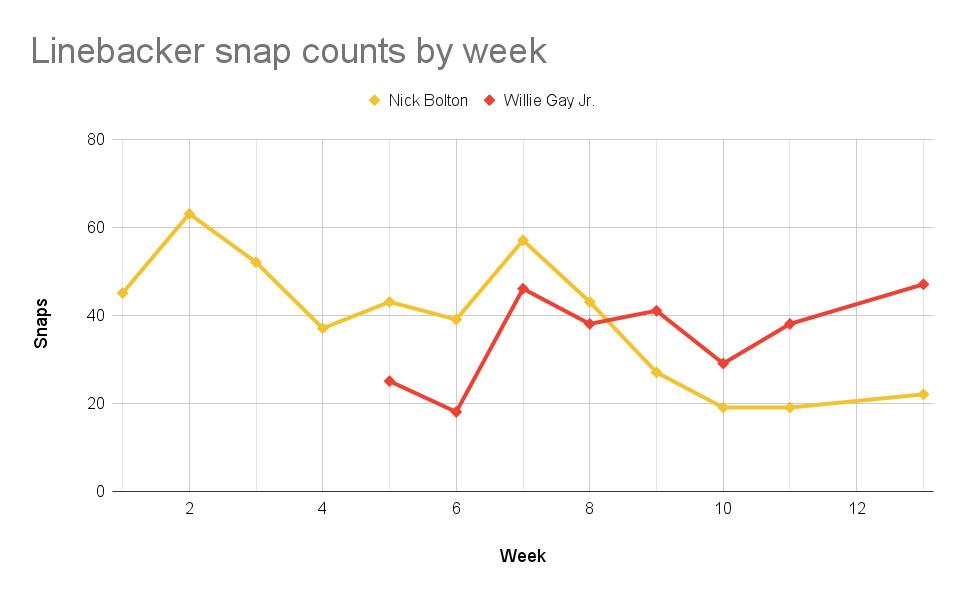
Gay’s emergence as a gap shooter has, in large part, replaced Bolton’s role on the defense; his talent as a zone coverage defender has far exceeded what the Chiefs were getting from Bolton. But the Chiefs are also getting a different linebacker involved in coverage: Sorensen. Despite losing most of his reps at safety and slot corner to Thornhill, Sorensen retained his box reps. He’s still not a great cover guy, and I’m not sure if the Chiefs really should be playing him over Bolton, but his role as the Chiefs’ dime linebacker serves as a good reminder that all of these improvements are interconnected—that a rising tide can lift all boats.
I’m not sure the Chiefs are really set at linebacker. I don’t think they think they are, either, as Spagnuolo said this week that he’s hoping to get Bolton more snaps. I’m not even sure that the Chiefs are set at cornerback, as Ward is playing better now than he ever has and could regress. Ditto for the defensive line—Ingram’s snap counts have been managed well to this point, but it’s not a guarantee that he and Clark both stay healthy, while Jones continues to be the best pass rushing defensive tackle in the league. That’s the thing about radical, sudden change: It doesn’t really feel sustainable, no matter how long it persists.
But if there is a case for sustaining this growth, it belongs to the final piece of this improvement that we haven’t discussed: Spagnuolo himself. If it were easy, every defensive coordinator in the league would take a bad unit, shuffle around some of the starters, make a cheap trade deadline acquisition, and just substantially improve the unit—but that doesn’t happen. Yes, teams try—the Eagles have been rotating their starting linebacker corps all season, with only a marginal improvement on defense; the Rams added Von Miller, traded away Kenny Young, and have messed around with their cornerback rotation all season. It’s difficult to make as many changes as the Chiefs’ defense has and hit on almost all of them without messing something else up. That fine-tuning takes the deft hand of an experienced coach who truly understands how all of the pieces on his defense interact and how to handle the personal matters of those benchings and adjustments behind the scenes. Spags’s defense in Kansas City isn’t about scheme right now—it’s about getting the best players on the field in a manner that works, which makes them both highly variable and situationally effective. Nowhere is the effect of coaching more clearly reflected than in performance on third downs and in the red zone—the highest-leverage reps for a defense—and nowhere have the Chiefs been better down the stretch than in those areas.
More impactful than Ingram’s addition or Jones’s relocation or Thornhill’s reemergence or Ward’s effectiveness or Gay’s return has been the timely combination of all those factors. The credit for that goes to Spagnuolo. He did what few coaches on either side of the ball can claim they’ve ever done: He got pretty much everything right.
I don’t know if this will continue. I didn’t know in October, and I sure don’t know now. The truth, as it almost always does, lies somewhere in the middle of these two poles of Kansas City defense. They were never going to stay that bad, and now, they probably won’t stay this good. But the blare of the sirens has been quieted, and the state of emergency has been lifted in Kansas City. They’re a good team again–maybe not the best team, or the scariest team, as they’ve been in years past–but they’re a playoff team in the AFC. The credit for that belongs, against all odds, to the defense. My hat’s off to them.